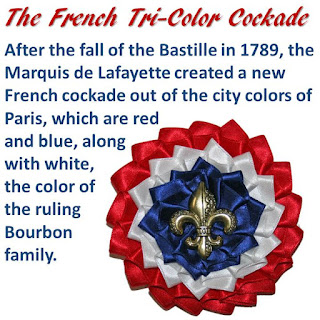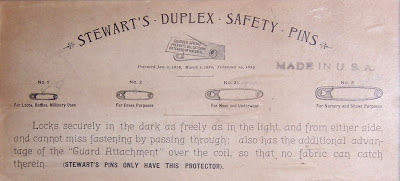 If you've watched the recent movie Les Miserables, you have seen the French tri-color cockade. Red, white and blue rosettes were inaugurated in the French Revolution and have been linked with the history of France ever since.
If you've watched the recent movie Les Miserables, you have seen the French tri-color cockade. Red, white and blue rosettes were inaugurated in the French Revolution and have been linked with the history of France ever since.The traditional colors of Paris were red and blue - red for Saint Denis and blue for Saint Martin. These colors were paired with the white representing the French nation (or France's royalty, as some claim) to make the tri-color combination during the Revolution.
This cockade was considered so vital in identifying your party affiliation that in 1792, a law was made requiring Frenchmen to wear the tri-color cockade. Further, the female club Societé des Républicaines-Révolutionnaires threatened to whip any woman who didn't wear the cockade, even though the cockades weren't mandated for women. Cockades were a pretty serious business!
 In subsequent years, those of the Royalist party would wear white cockades, while Socialists preferred red. So the tri-color eventually became a symbol of nationalism and moderation between the two extremes.
In subsequent years, those of the Royalist party would wear white cockades, while Socialists preferred red. So the tri-color eventually became a symbol of nationalism and moderation between the two extremes.By the time of the World Wars, airplane roundels were based on national cockades. France's roundel was, of course, the red, white and blue tri-color.
So that explains the French tri-color cockade. But what about the United States' tri-color cockade? Where did it come from? After all, if you've kept up with my blog, you know that the first American patriotic cockade was black and white, and later simply black. How did we go from black to red, white and blue?
The Union Tri-Color
During the French Revolution which followed shortly on the heels of the American Revolution, many Americans sympathized with the revolting French. Thomas Jefferson was one of them. The "Francophiles," as they were sometimes called, wore the French tri-color to show support for what they thought would be a similar bid for freedom in France. This, by the way, is the cockade worn by James Monroe as American Minister to France in 1794.
 But others in America were concerned by the excesses they saw in the French Revolution, and the casting off of all authority, including God's. They still clung to the old Federalist black cockade.
But the Federalist party was soon to fall into disrepute (see my blog entry on black cockades for reasons why) and the black cockade would fade away with it. Thus was left for American patriots: The tri-color cockade!
But others in America were concerned by the excesses they saw in the French Revolution, and the casting off of all authority, including God's. They still clung to the old Federalist black cockade.
But the Federalist party was soon to fall into disrepute (see my blog entry on black cockades for reasons why) and the black cockade would fade away with it. Thus was left for American patriots: The tri-color cockade!By the time of the American Civil War, red, white and blue cockades were firmly linked with United States patriotism, although there were many variations. A newspaper of the time describes one design this way: "The Union Cockade: This is also a double rosette, the center one being of red silk, the inner one of white silk, and the pendants of blue. The gilt button that fastens the whole together shows the eagle of America surrounded by the stars of the United States."(The Rolla Express, January 21, 1861)

 Here are a couple of pictures of patriotic gentlemen from the 1860s, wearing their Union cockades. As you can see, these are a couple more designs based on the red, white and blue theme. Some Union cockades had stars in the center, some had pictures of George Washington or other famous Americans, some had a military button, some had nothing at all but just pleated or gathered ribbon.
Here are a couple of pictures of patriotic gentlemen from the 1860s, wearing their Union cockades. As you can see, these are a couple more designs based on the red, white and blue theme. Some Union cockades had stars in the center, some had pictures of George Washington or other famous Americans, some had a military button, some had nothing at all but just pleated or gathered ribbon.Even up through the 1940s and World War II, Union cockades were worn to show patriotism. This is a US cockade in my collection from the World War II era. Cute little fashion statement, isn't it?
Of course, if you'd like to wear a tri-color cockade as a fashion statement now (whether French or American) I have a number of options in my shop.
And three cheers for the Red, White and Blue!









